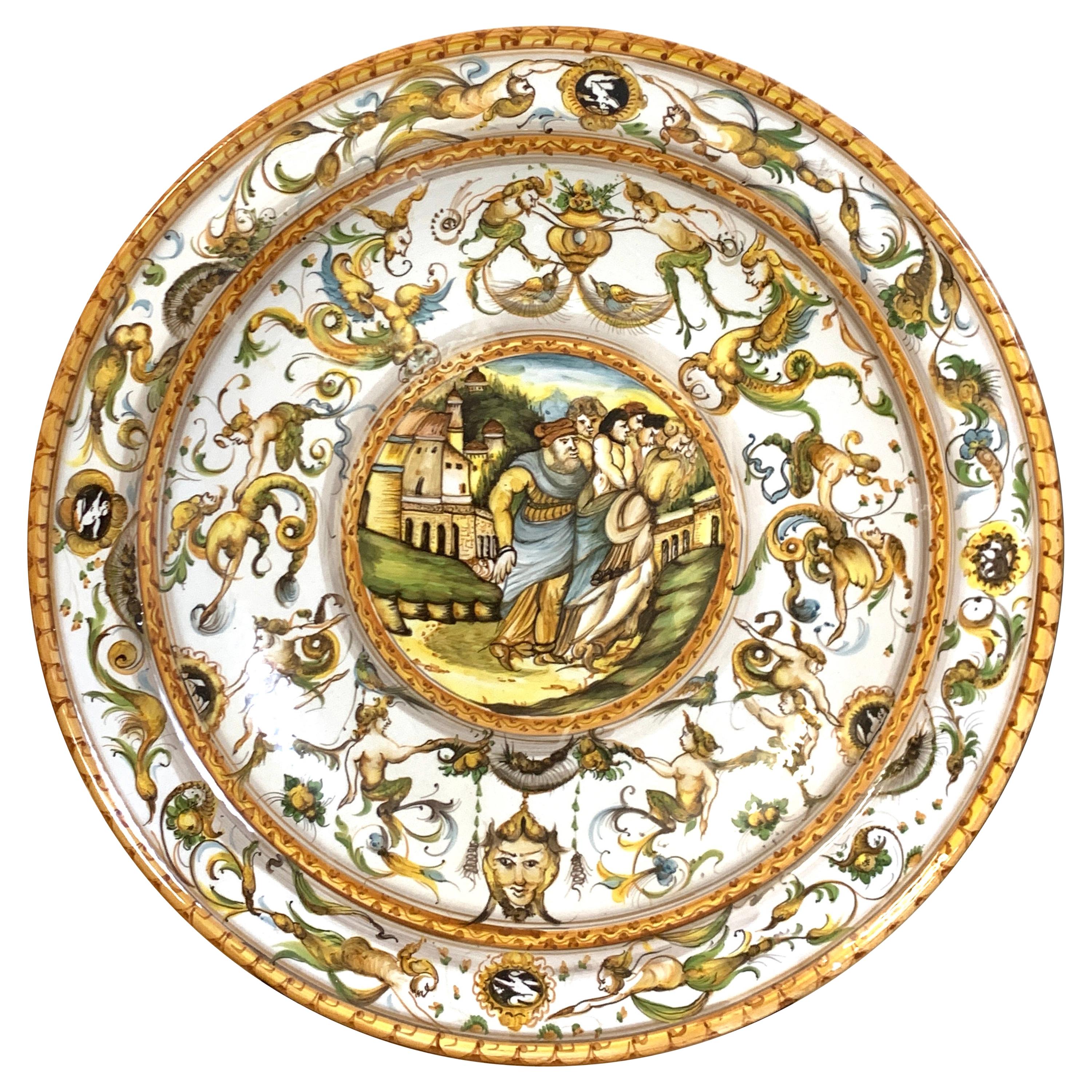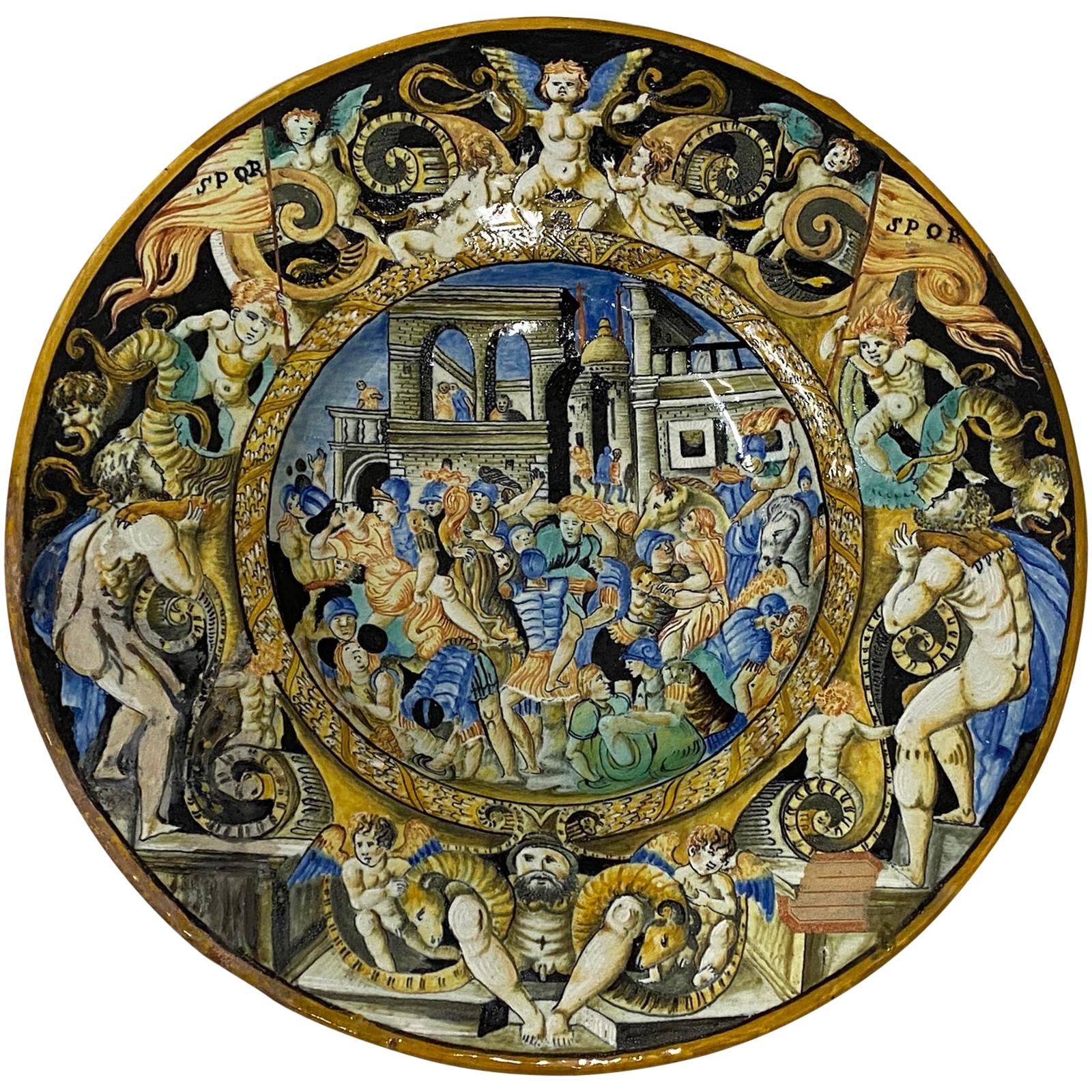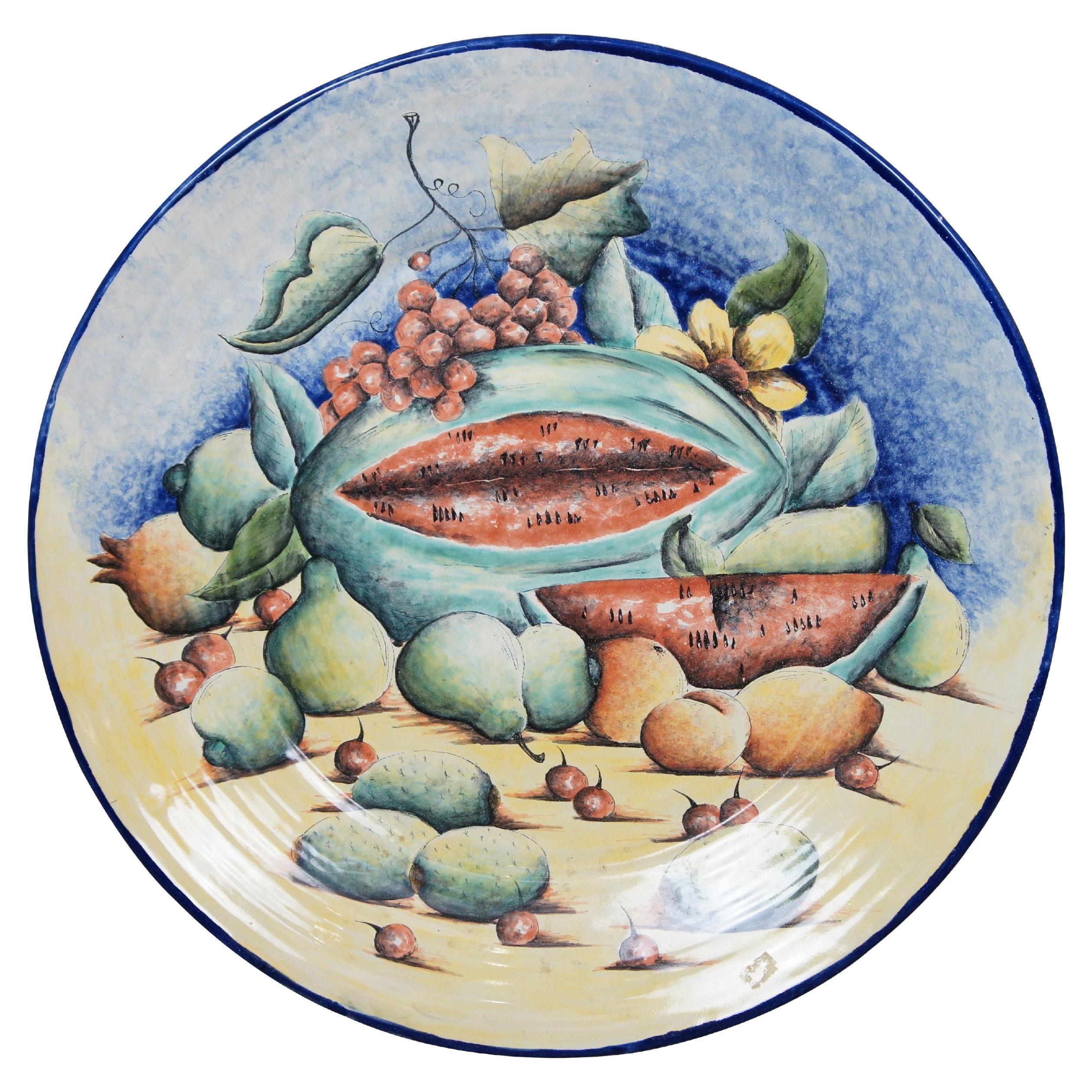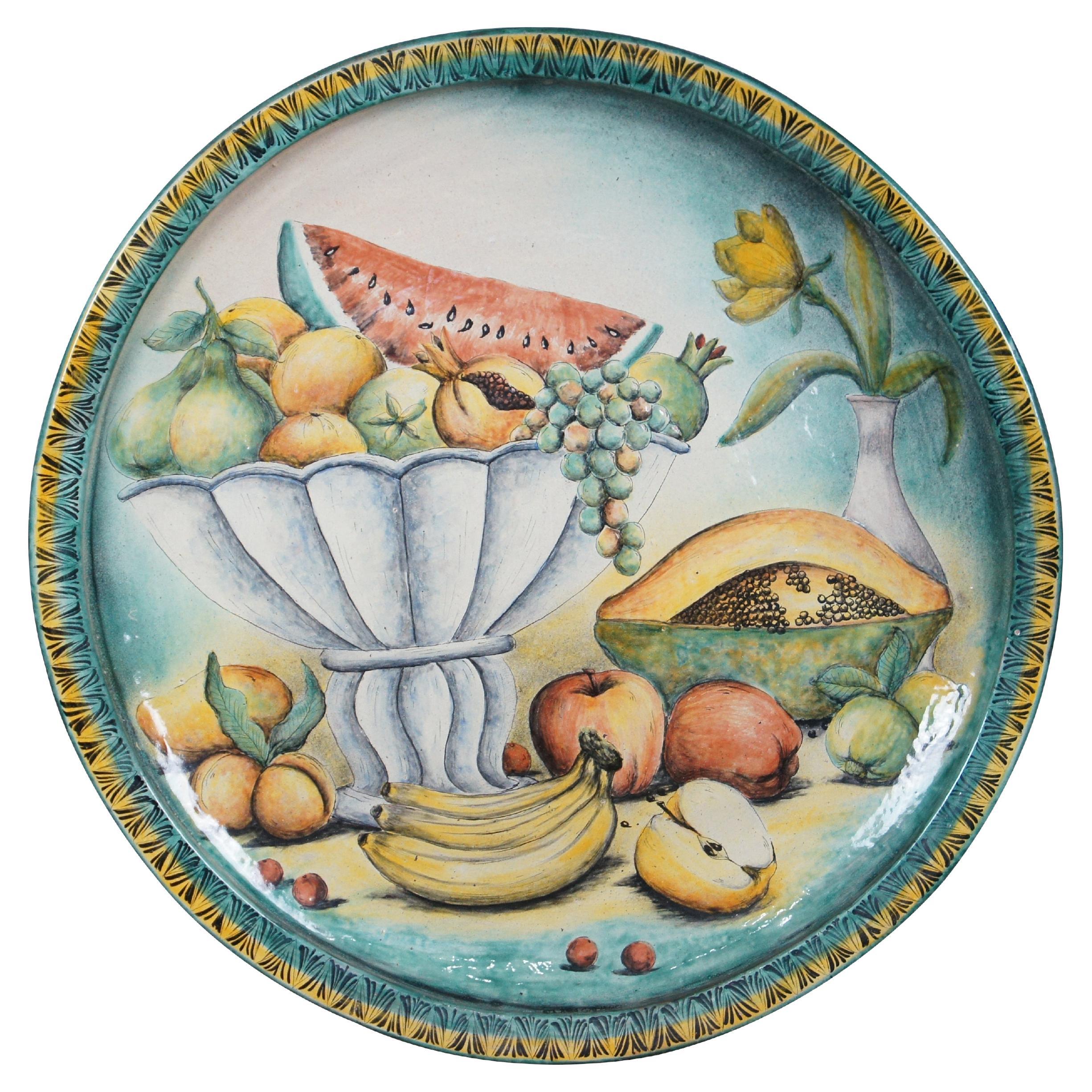Items Similar to Antique Italian Renaissance Raffaellesco Grotteschi Majolica Wall Charger
Want more images or videos?
Request additional images or videos from the seller
1 of 12
Antique Italian Renaissance Raffaellesco Grotteschi Majolica Wall Charger
About the Item
A stunning large antique Italian Raffaellesco majolica wall charger / centerpiece, showcasing exceptionally executed handmade and painted design, dating to the 19th century or earlier.
Shallow bowl-form plate - platter raised on circular foot, yellow lustware pigment, later drilled with string added for wall hanging. Featuring artistic medieval Renaissance Grotteschi style, decorated in intricate highly stylized foliate scrolls, mysterious masks, dragons and grotesques.
Signed in blue against bisque underfoot, 121 with a symbol that appears as a S within a C and/or N with a diagonal line through it.
Dimensions: (approx)
13.75" diameter, 2" high, 2.75lbs
Condition:
Great condition overall, having warm, nicely aged patina, small area of old restoration work at left grotesque's tail, and typical scattered minor antique character marks, all wear consistent with age, nothing that detracts from the overall display but only adds to the sophisticated character, elegant warmth, and rustic European old world charm!
History:
The Italian pottery / ceramics known as maoilica is highly desirable and sought after due to the polychrome painted tin-glazed earthenware that makes the pottery gleam with bright vivid colors that never fade.
The history of majolica is as intricate and colorful as the designs that adorn it, spanning 800 years of Italian ceramic tradition. This form of glazed pottery, renowned the world over for its vibrancy and artistry,
Italian maiolica was first produced around 1350, but it wasn’t until the height of the Renaissance that the pottery reached its artistic peak.
Early maiolica had a limited color palette; a classic white base with manganese (brown) and copper (green) glaze designs. By 1460, the technological advancements in kilns and glazes combined with the flourishing artistic prowess of the artisans brought us the vibrant, polychrome ceramics that we associate with Italian pottery today. By the end of the 15th century, small towns were renowned for their high-quality maiolica and each town had developed their own distinct styles. Some were larger cities, such as Siena, but more often they were small towns whose market was a large nearby city to which they were politically affiliated. Two prominent examples were Deruta, near Perugia and Montelupo, near Florence. Both of these towns are located along riverbanks – the Tiber in Umbria and the Arno in Tuscany – where there are natural clay deposits, perfect for the production of maiolica. Once the Italians became experts in the craft, Italian ceramics became world-renowned.
During the 16th century, the Raffaellesco character became a popular design in pottery. Raffaellesco is the namesake of one of the Great Masters, Raphael (Raffaello Sanzio da Urbino, 1483-1520), a painter and architect. His frescos featured a creature which came to be known as a “grottesque”, a design that combines human, animal, and botanical forms. An example of this sort of creature can be found in Raphael’s “St Michael Trampling the Dragon”. Though the version of the dragon in Raphael’s painting is a dark, sinister-looking beast, the romantic Italians allowed the image of the dragon to evolve into a much lighter, more benign creature.
The Raffaellesco we know today is a benevolent deity, bestowing good luck and fair winds to all who cross his path.
The remarkable skills necessary to produce these ultra-refined paintings on ceramics is truly impressive.
- Dimensions:Height: 2 in (5.08 cm)Diameter: 13.75 in (34.93 cm)
- Style:Renaissance (In the Style Of)
- Materials and Techniques:
- Period:
- Date of Manufacture:19th Century
- Condition:Wear consistent with age and use. Great condition overall, having warm, nicely aged patina, small area of old restoration work at left grotesque's tail, and typical scattered minor antique character marks, all wear consistent with age.
- Seller Location:Forney, TX
- Reference Number:1stDibs: LU5977230204842
About the Seller
4.8
Platinum Seller
These expertly vetted sellers are 1stDibs' most experienced sellers and are rated highest by our customers.
Established in 2013
1stDibs seller since 2021
200 sales on 1stDibs
Typical response time: <1 hour
- ShippingRetrieving quote...Ships From: Forney, TX
- Return PolicyA return for this item may be initiated within 7 days of delivery.
More From This SellerView All
- Fine English Staffordshire Majolica Lion Handled Tureen Lidded DishBy StaffordshireLocated in Forney, TXA scarce fine quality antique English Staffordshire pottery majolica tureen covered serving dish. Having a fitted lid surmounted with figural reclining lion finial with hand pain...Category
20th Century English Victorian Soup Tureens
MaterialsCeramic, Majolica
- Antique Continental Renaissance Church LavaboLocated in Forney, TXA magnificent medieval Renaissance period architectural holy water font lavabo. Born in a Christian church in Continental Europe during the middle ages, likely Italian 16th or 17th century, exquisitely hand-crafted by a highly skilled artisan, with exceptional craftsmanship, ornate and finely detailed, the rare and one of a kind forged bronze and brass upper presenting with gothic shaped palm frond back, domed lid with tall finial decorated in relief, the fountain reservoir is decorated with central mounted Star of Bethlehem four pointed pentagram star embellishment as well as other applied ormolu adornments, a narrow elongated spigot with valve dispenses the holy water below. A later gilt brass stoop catches the water, the nicely styled, demilune shaped wall mounted antique...Category
Antique 17th Century European Renaissance Fountains
MaterialsBrass, Bronze, Ormolu
- Antique German Art Nouveau Hand Painted Terracotta Charger Wall PlateLocated in Forney, TXA beautiful hand-crafted and hand-painted terra-cotta charger wall plaque, Germany, early 20th century, featuring an exceptional painted scene with woman and bird in courtyard, signe...Category
Early 20th Century German Art Nouveau Decorative Art
MaterialsTerracotta
- Pair of 19th Century Provincial Italian Renaissance Revival Sgabello Hall ChairsLocated in Forney, TXA pair of antique, circa 1830, Italian Renaissance style hand carved walnut sgabello hall chairs. Hand-crafted in Provincial Italy, most likely ...Category
Antique 19th Century Italian Renaissance Chairs
MaterialsWalnut
- 19th Century Italian Renaissance Revival SideboardLocated in Forney, TXA rare Continental Italian Renaissance Revival oak and leather sideboard with warm, rich patina. Born in the early 19th century, exquisitely hand-crafted and exceptionally execut...Category
Antique Early 19th Century European Renaissance Revival Sideboards
MaterialsLeather, Oak
- 19th Century Italian Renaissance Revival Curule StoolLocated in Forney, TXA exceptionally carved Italian Renaissance Revival figural curule stool. Born in Italy during the late 19th century, hand-crafted of warm, rich, finely carved solid walnut, finished in medieval Henry II style / Italian Empire taste, featuring X-frame with curved armrests ending in ornate stylized lion's head / griffin grotesques, having an upholstered seat cushion adorned with nail head trim, rising on foliate carving turned stretcher-joined richly detailed acanthus leaf accented legs, terminating in finely sculpted lion paw feet. A wonderful example of functional art, the impressive antique, circa 1880, having beautifully aged patina over the whole, retaining original antique character throughout, worn smooth, naturally distressed patina that does not detract from the overall display, but only adds to the elegant rustic warmth, historical depth and European old world charm. Dimensions: (approx) 25.5" High, 34" Wide, 16" Deep Seat height: 16" Great antique condition. Presents well, having nicely aged patina. Later antique metal plate...Category
Antique 19th Century Italian Renaissance Revival Stools
MaterialsUpholstery, Walnut
You May Also Like
- Massive Italian Majolica Allegorical Charger by A. DerutaBy DerutaLocated in West Palm Beach, FLMassive Italian Majolica allegorical charger by A. Deruta Gorgeous continuous Italian Renaissance style decoration Ready to hang.Category
20th Century Italian Renaissance Ceramics
MaterialsMajolica
- Torquato Castellani Majolica Renaissance Revival Tin-Glazed ChargerLocated in Bishop's Stortford, HertfordshireAn exceptional Renaissance Revival Maiolica tin-glazed plate painted with a side profile portrait of a lady within a decorative border with a line painted design to the base. The lig...Category
Antique 1880s Italian Renaissance Revival Ceramics
MaterialsMaiolica, Earthenware
- Ginori 19th Century Italian Renaissance Style Big Majolica VaseBy Richard GinoriLocated in Brescia, ITBig Majolica vase Ginori Italy, 1850-1890 Very good codiction Difetto di cottura sotto la base (vedere fotografia)Category
Antique Late 19th Century Italian Renaissance Ceramics
MaterialsMajolica
- 19th Century Italian Majolica Dish with Renaissance FiguresLocated in San Francisco, CA19th century Italian Majolica dish with Renaissance figures Superb highly decorated Italian Majolica plate with hand a hand painted scene of Roman mythology; The abduction of Sabine...Category
Antique 17th Century Italian Ceramics
MaterialsCeramic
- 24" Polychrome Ceramic Painted Mexican Majolica Art Pottery Wall Plate ChargerLocated in Dayton, OHA beautiful 20th century Majolica Platter / Decorative Wall Plate. Made in Santa Rosa de Lima (Villagrán), Guanajuato. Features a hand painted still life of watermelon and other fruit. The foreground of the plate is blue along the top with a sand color towards the bottom. Spanish-influenced Talavera and Italian Maiolica are sub-genres. Mexican Majolica...Category
20th Century Folk Art Ceramics
MaterialsMajolica
- 27" Polychrome Ceramic Painted Mexican Majolica Art Pottery Wall Plate ChargerLocated in Dayton, OHA beautiful 20th century Majolica Platter / Decorative Wall Plate. Made in Santa Rosa de Lima (Villagrán), Guanajuato. Features a hand painted still life of a compote with pears, grapefruit and a watermelon. A papaya, apples, bananas and more fruit are resting next to the compote. Towards the back right is a vase with yellow flower. The foreground of the plate is green with a yellow edge and black decorative pattern. Spanish-influenced Talavera and Italian Maiolica are sub-genres. Mexican Majolica...Category
20th Century Folk Art Ceramics
MaterialsMajolica
Recently Viewed
View AllMore Ways To Browse
Antique Green Ceramics
Antique Silver Paint Color
Antique Silver Symbols
Large Silver Charms
Glass Lighter
Antique Silver Chargers
Antique Silver Charger
Renaissance Style Silver
Antique Glass Symbols
Old Italian Ceramics
Antique Italian Old Masters
Antique Yellow Paint Color
Antique Glass Fairs
Antique Symbols On Silver
Green And Brown Majolica
Antique Charms Silver
Antique Silver Charms
Silver Antique Charms





